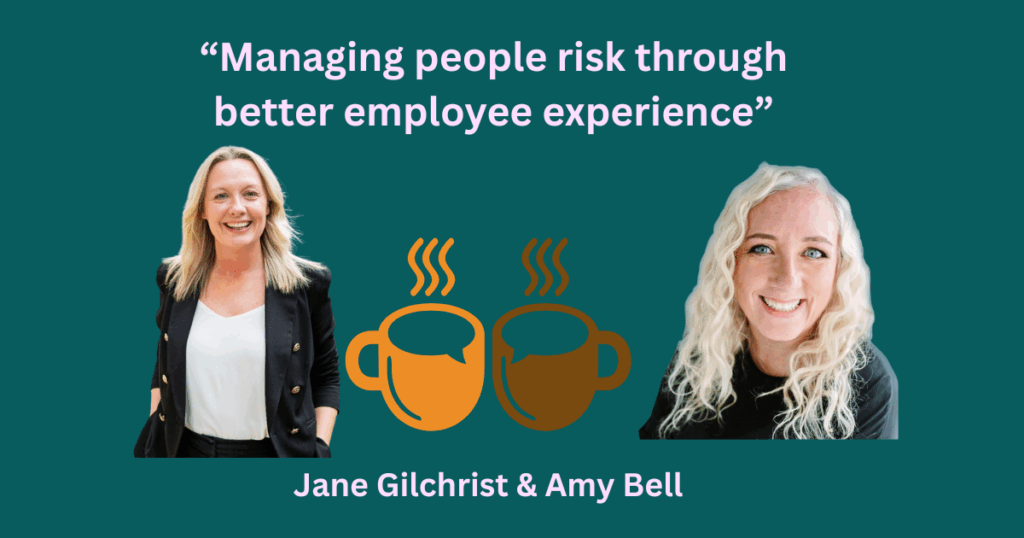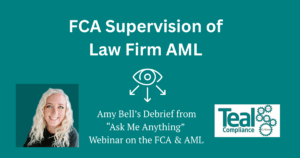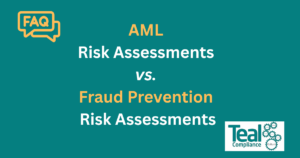My name’s Amy Bell, and I’m the CEO and founder of Teal Compliance, and we host a number of free webinars, mainly monthly.
One of the reasons I think that culture and the environment that we work in is so important to running a successful law firm for compliance. If people aren’t happy, then they’re certainly not complying with what you ask them to do.
I welcomed Jane Gilchrist to join me in Teal’s Coffee Conversation on 14 May to talk about law firms and the people who keep them compliant.
You can catch up on the actual recording HERE or if you’re like our Head of Marketing, Elaine, then you’ll love a good read (and this is it!).
Here’s our conversation so it reads as a chat.
Amy Bell and Jane Gilchrist
I’m Jane Gilchrist. I’m one of the co-founders of the law coach collective. Prior to that I had a 20- year career across the legal sector, starting from being a clinical negligence fee earner working my way up to overseeing legal service delivery and global head of governance.
Jump forward and I’m now working with law firms and other professional service businesses, helping them get a really clear strategy for leadership and culture that genuinely supports their people. It helps them to grow and perform at their best.
The work we do is focused on helping firms to develop leadership roles to understand what those roles are, and what they need to deliver for the business. We then look at how we can develop their leadership pipeline to deliver tools that help them manage their people, the business risks, and of course to retain their talent. All of our work is there to align with their business strategy – I am not a tick box person.
FRAMEWORK of Coaching
A big part of what we do is focused around our implementation of a framework, which is a blended approach of learning and coaching. We really support people to take action in real time that’s relevant to their environment. Focusing on that framework being embedded so that it doesn’t stay in the training room, as we want to see change actually happen and so do our clients.
We focus a lot on those non- technical skills for lawyers who need these tools to succeed in their career, but also to help the firm develop the culture they strive for, so that they can all thrive.
We’re massively proud of what we’ve created. We’ve aligned our framework to the SRA competencies and also SRA guidelines. We’re recognised by the Leadership Institute, and we can also offer CPD accreditation against some of our coaching programs, which I think is pretty unique.
Are we helping our managers to manage people properly in the legal profession?
Amy Bell:
Are we actually giving their people the skills that they need to be people managers, because when we set off to be lawyers (like my daughter at the moment – she’s next door revising for her A levels; she’s going on to do a law degree ….. I’ve tried to talk her out of it!).
So my daughter wants to be a lawyer. Why? Because she wants to change the world. Like many of us, we’re attracted to the law because we like solving problems for people. We like taking a problem and applying the law to it and saying, this is the answer, we really like that. But when we end up working in a law firm we quickly realise that it’s often about people-politics.
We have to deal with so much people-politics in law, don’t we? We’ve got people underperforming or even overperforming, and we’ve also got to make a business that is profitable and works. Nobody really tells us that, they don’t let us into that little secret when we sign up for the LPC!
Those people who might not know this about me. I used to work in a law firm. I was there for 12 years, and for seven of those years I was Head of Learning and Development as well as anti-money laundering.
We need to look at our firm and our people within. Have our people actually got the skills to cope and to learn?
We wonder if we are training them properly or are we part of the problem? By this I mean, we might not be training them properly. By not training properly we create environments that people find challenging to work in.
Jane Gilchrist:
I think that’s a really important question. Are we part of the problem? And I think if I’m completely honest with you, from my experience of working in coaching, yes we are, however unintentionally.
We’ve seen all the stats around this subject. All of us will have seen those on accidental managers. Over 80% of managers have not had any formal leadership training.
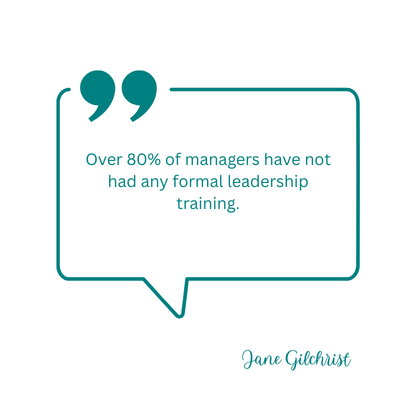
Definition of what a Leadership Role is
I think a lot of it starts with firms not really defining what a supervisor or line manager partner, or whatever it’s called in each firm) team leader role is, and what it actually entails.
It’s rarely clearly defined. In reality, it’s a blend of supervising the quality of the legal work, isn’t it? And making sure that the client gets what they need, that they’re supported, that they meet all the compliance and regulatory requirements.
But a big part of it, as you said Amy, is actually developing the individuals that we are supporting and spotting potential risks, but also in terms of ourselves.
Role modelling the right behaviours is really important, so that we’re upholding the firm’s culture on a day to day basis. That’s where we could probably do a lot more to support people, for sure – the sweet spot.
Amy Bell:
Our Six Cs of Compliance aligns with what you’re saying.
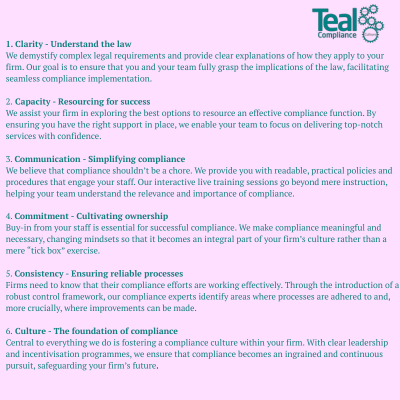
The biggest C in our cog logo, is culture, which is at the bottom of our logo and it’s at the bottom because if you don’t have a culture that supports compliance, you can’t do all the other five bits, and it will all come tumbling down without a healthy and supportive culture.
One of the biggest challenges I believe we have in the legal profession is the fact that we haven’t got this dedicated people strategy. We’re not purposefully creating a culture. And if it happens, it’s more accidental than by design …
…. and then it starts to fall apart. If that one person who’s really great at it leaves, or gets promoted away from managing the people, then what?
Amy Bell:
One of the things I’ve always been interested in is progression through a law firm. In our profession it’s quite a hierarchical kind of structure.
In my experience, I have seen the way law firms work in that it’s often the people who get promoted to partner often are promoted because of their ability to earn fees and excel at practising the law. Suddenly, however, they now have to manage people and teams. Yet they haven’t been trained in leadership and management skills.
Jane Gilchrist:
I think just focusing on managers or line managers is a wasted opportunity. At the end of the day you lead yourself every day, don’t you? Whether you’re an admin assistant, whether you’re a trainee or whether you’re a senior partner, you lead yourself every day, you make decisions, you manage your time. You interact with colleagues, you interact with clients
Do you influence a healthy workplace environment?
Jane Gilchrist: I’ve definitely worked with managers before, where they’ve barrelled in in the morning, and that has either made the day for everyone, or broken the day before it’s even started. They’ll either come in and say good morning to everybody, or just go to their desk. And you know that you’re in for a difficult day ahead. The eggshell boss.
Giving people the skills really early throughout their career to understand their own effect on colleagues is important. For all of us, having an awareness of the way we act, what levels of emotional intelligence we have, how we understand our own influences and impact on others is a true skill.
Amy Bell: It’s about how to figure out how to communicate effectively isn’t it, and actually taking the time to do that, instead of assuming your colleagues know what is going on.
Jane Gilchrist: You say, people in compliance can feel that because they haven’t got a fee attached to their role that it’s really difficult for them to show how they add value, and they can immediately feel on the back foot with that. Yet they are so valuable to this business. They keep the firm safe!
Law Firms and the Hierarchical Politics
Back to hierarchy though. The first thing I would say about it is that I can see why it motivates people in the legal sector, because whatever route you’ve come in on, it’s all focused to get in that title at the end of it, isn’t it?
To be a solicitor.
Jane Gilchrist: Personally, I don’t massively have strong views on the hierarchy as long as it is cross functional, and that it’s enabling people, not stifling people.
What I see in the work I do is that there is a tension between apprentices between trainees in terms of who’s getting what work, how that all works, how their careers develop, whether anyone is a disadvantage to the other. And I think it all boils down to the fact that on your route into the profession, and to get to that title of a “solicitor”, it’s crystal clear to them.
But the career path to be a solicitor can be ambiguous and that throws in doubt and anxiety. People aren’t quite sure what they need to do to progress, or how they can put themselves in a better place to progress, and I think we should probably put a lot more focus around that and really define some milestones along the way, not just in terms of what they need to achieve in their career, but also things like behaviours, competencies, skills, and just make sure that it’s a really holistic view to supporting people on their legal career.
Amy Bell: I could not agree more. I’ve just shared with you, haven’t. I’ve just come off a call with one of my team, a relatively new starter and one of the things that I did. And if you’ve listened to me talking about these kinds of coffee conversations before, you’ll know that when I started Teal I gathered all of the ideas of things that we hated from where we’ve worked in the past, and we would try and do the exact opposite!
One of the things that we do is we measure people on values, so they can say whether they disagree or not, I don’t mind, but there are. There is very precise and scientific analysis of my business to make sure that it is profitable. It works, and we want to put more money into delivering better solutions for clients.
We work so well as a team, all of us. We work well with our values and then we’re able to invest in our software or whatever, or new people to continue to grow whilst we look after each other. There’s a LOT of detail that goes into Teal as a business! There’s a whole management meeting every Friday morning where we go through a set of numbers, but my team doesn’t feel that they’re measured on numbers.
Do your firm’s core values align to your actual way of working?
Amy Bell: I don’t want my team to be distracted or feel that they’re measured based on numbers. What they’re measured on is good quality work which is being produced in timescales that work for the client, and that are at the standard we want and need. Part of the measurement is how their own values light up the team as a whole. If you haven’t got those core values that I started Teal with, how can anyone possibly be able to know what they’re expected to do?
Jane Gilchrist: It’s Important when you see firms who’ve got multi sites as well, so they might have branch offices. It’s easier to start from one point and educate and train your offices and teams the same thing in a consistent way but ultimately it’s about values.
For example, how can I actively demonstrate those values through my behaviours on a day-to-day basis? If I set them out really clearly and then help others, because it’s very different in different locations isn’t it? If you’re just working on your own, you’re not a line manager to anybody else. Then how you demonstrate those values will be slightly different to what they need to be. If you are managing a team, things like role modelling, oversight and supervision support all of those things. But also if you’re leading the firm in terms of clarity of vision, setting strategic goals, making sure that everything’s aligned can be different location to location.
Amy Bell: I’m very happy to share how we did it. I was just actually saying that. We put our values on our mousemats!
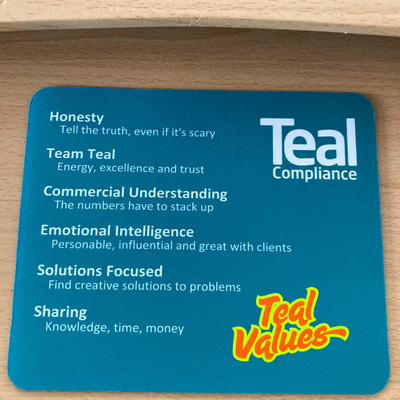
How Teal Compliance Recruits
Amy Bell: Like I said we don’t want pure replicas of existing team members, but need the values and ethos of those people to fit. How do we measure and track that our recruitment for like-minded professionals work?
We survey the team every month asking them to tell us who their Teal Stars are that have demonstrated the values this month. It’s nothing to do with the billing target. It’s nothing to do with productivity, because my logic is as long as you get people who are committed to doing good work and enjoy being here, then the rest will just follow efficiently. Generally people want to do a good job.
Jane Gilchrist: Yep! 100% believe that for sure, when you look at what some of the biggest people risks are and why people leave law firms. It’s because there is a mismatch between what the firm says the culture is and what they experience on a day-to-day basis. So, managers are often the missing link between those two things, but the more that we can enable and equip the managers with the right skills to be able to deliver that on a day to day basis and really think about their interactions with their teams, as well as how to get the most out of those, then deliver those values for pure visibility …. It makes a huge difference.
Amy Bell: And the role modelling point which you mentioned a couple of times, I think it’s just so important, because if you want to know the quickest way to trash a compliance program is to let a person of influence, whether that’s Jane Doe in legal accounts, Jane Doe-Mark Two on reception or John Doe, the Senior Partner of the business NOT show you up and be an effective role model.
Jane Gilchrist: I’ve been in team meetings before, where a director may have come in and said, “oh, well, this is the word that we’ve got from the powers that be. I don’t necessarily agree with it.” Nobody is going to take it seriously, and values are a bit the same, aren’t they? If we say integrity is our value. And then, you see a manager sort of talking poorly about somebody at the water cooler. Then it’s done.
Integrity – you’ve absolutely got to live and breathe it.
Tips for AML and People Management
Amy Bell: I’ve explained how we did it at Teal and how we continue to monitor ourselves, but can you give us any other good tips you’ve got for a firm that either has done this values exercise, and they’re not kind of feeling it? How would you go about it? How do you help people do that?
Jane Gilchrist: I think the biggest thing for me is to reflect on them really regularly. Sometimes firms will agree on their set of values, and they’re on the wall forevermore.
We want to know from them how they think they demonstrate their values to their team. If they can show us from their colleagues how they would be able to mirror those values is key to us.
I’ve actually sat with firms where we’ve had working parties, representatives from all across the firm, or roles or departments, and they’ve put post-it notes all over the wall in terms of what they think the values are and how they demonstrate them. And then when you see the same ones popping up again and again and again, they are absolutely your values.
How good are you at receiving feedback?
Amy Bell: One thing I think I recognise, because I’m rubbish at it, is receiving feedback, getting good feedback. Never mind bad stuff! I want to curl up in a corner and cry, and nobody ever taught me how to do it. Nobody ever taught me to, because as well as we’re not teaching people how to deliver it. We’re not teaching people how to receive it. NOTE for readers please read AMY’s personal blog to find out more.
Jane Gilchrist: Yes, and how to depersonalize it, because sometimes you only ever give feedback how you would like to receive it, not necessarily thinking about what’s going to be really important for them. What do they need to take from this? And let’s focus on that which can help to de-personalize it? And rarely are you giving feedback on an individual on a personal level.
You know you might be talking about behaviours that they’ve demonstrated at that particular time in that particular moment or a piece of work, and I think it’s really important to get that across so that people don’t feel that it’s a personal attack. It’s not easy to receive feedback, is it?
Particularly when it’s not great, but usually it feels like that, because it sometimes hits home.
You need to sit with it for a little while.
Amy Bell: It’s the combination of the person giving the feedback possibly tripping up over themselves when giving it, by that I mean the person receiving the feedback might not hear properly what the giver is intending for them to hear. Lost in translation. That is definitely a lesson I’ve learned in my career. I thought I had said something, but they heard something else.
Being able to communicate that really clearly, which can be really difficult if you’re scared of them bursting into tears or something. But they shouldn’t be bursting if it’s a two-way street in a healthy and safe place.
It comes back to psychological safety. That was a term that was used in the call I had with my new employee. It feels like a safe place for anyone to put their hand up and say, I don’t know how to do this. Why do I ensure my team and I work in this safe place?
Yes, we have got loads of rules as we are a compliance business, but our main rule between our team is that if you are stuck for 10 minutes, you ask for help.
Top Tips for Compliance and Psychological Safety
Amy Bell: Having the 10-minute Rule and then asking for help is our Number One Rule at Teal. It’s not efficient for you to sit there for longer than 10 minutes worrying about something. So that means it’s costing money. And it means other jobs are going to drift. And then clients aren’t going to get the service that they’re wanting to get.
That’s the first practical reason for it, if you need one!
But the real reason for it is, I don’t want anyone sitting there worrying so we literally have a dedicated communication channel like a lot of firms. We use Team for instant messaging and I can’t tell you how much we all use it and how quickly our cries for help are solved! We all use it, including me.
Questions like, can someone tell me the answer to “this”? Does anyone know “that”? etc.
The reason that we do that at all levels in the business is so everyone can see those questions and sees that it truly and really is safe to put your hand up and say, I don’t know.
We all collaborate on the answer, and the query is solved in minutes.
Remote Working and People Management
Amy Bell: We are a remote team here at Teal, in the main and this is one of the challenges I find which is why we had to find a genuinely great way of communicating. But one of the challenges that I find speaking to law firms these days is when they are still doing a good proportion of remote working and therefore managing supervision and support in that remote environment.
You simply can’t actually get body language from them can you?
Jane Gilchrist: Yeah, but it’s really difficult, isn’t it? It’s about getting to know your team and checking in on them on a regular basis. It’s about having a catch-up in the diary, whether that’s weekly or monthly. The fact your remote colleagues are used to you asking how they are! We have found that without those call catch ups it can become a little weird and people can become phone phobic.
The mobile goes or the Teams’ noise echoes out and we think what do they want?! But because you are used to having chats on the phone with catch ups, when the phone goes, it’s not scary or anxiety inducing, because you’re used to having them on the phone. You haven’t got that initial panic when their name pops up on teams.
If the usual scenario is radio silence, your team is definitely NOT going to come to you when they’ve done something wrong. And so sometimes we hear a lot about, “let’s share our wins”. Sometimes it’s about “let’s share some of our really big icky things”, “ or really awful conversations that I had to have to sort this out”.
Jane Gilchrist: I would self-refer to the managing partner and say, I’ve dropped the ball on this, how can we make this better? Just really talking about those sorts of things can massively start to normalise some of it.
Amy Bell: That’s exactly why I wanted to make sure I did things differently from my experience previously. We have a long running client that outsources their compliance to us. I have been working with them for 12 years now and I still remember the first time that we discussed this very subject with them. How to try and create a culture of people being able to put their hand up and say, I’m stuck without fear of reprisals.
My tip is that if you need a business reason for it, the 10 Minute Rule or just to feel safe to put your hands up and say you think you’ve mucked up, then you can justify it because by admitting something early on reduces the risk of professional indemnity claims! That’s a fact.
If a firm can evidence that the initial mistake was highlighted early on, and then what the firm’s attempt at rectification was, that’s a big tick for PII because insurers know that everyone, and every firm at some stage will make a mistake, it’s how you try and fix that mistake that counts.
Amy Bell: Anxiety and Solutions
Amy Bell: I’m going to tell you. I used to cock up pretty regularly. I had to have months off sick with stress from it, because I never felt confident enough in this hierarchical situation. Dog eat dog. Everyone’s trying to get the same job as a partner. I didn’t say anything. It made me ill.
When I came back from sick leave I started a group: Bring Out Your Dad meetings.
It was for peers, and I’m like, just bring the files you’re stuck on. We’ll workshop them together. There’ll be a great learning example for everybody else to just come along and listen to. So, we’re doing great training. But also, it means you won’t be stuck on that file anymore, and you won’t be waking up at 3am in the morning worrying yourself sick about it.
Jane Gilchrist: Similar actually in a team that I was running in, that we had a black box system. If you had a file that you absolutely had lost your way on you could put it in the black box. It gets passed on to somebody else. They would work it through, because it’s always easier to sort out somebody else’s difficult file than your own, isn’t it?
And quite often it’s never as bad as you think it is. Once you sit down and actually do the work; it just gets this nuclear field around it, and you know, as a coach people think, “you must be perfect” … absolutely not!
The shelf in the office…..
Amy Bell: I had that shelf. It was at the bottom. It was underneath the Law Gazette! They used to come every week. Those of you new lawyers will have no idea what we’re talking about if you’ve not had files, but for us that have been doing this law thing for a while, it’s the bottom shelf, covering dust behind the desk!
I’m like, what are those files behind your desk? Oh….so nobody else roots through them and sees I’m behind or stuck and I’m scared. And this is why the root cause analysis of things like complaints and claims is so important.
Spoiler Alert! The root cause analysis, if you don’t already know this, it’s likely to be 5 questions away….. In my experience. The FIVE WHYS is the root cause analysis model, which I love. It’s dead simple. Ask yourself why something happened five times.
You are going to unearth what was really underneath it. It’s pure psychology.
We use it in our TEAL TRACKER software. We have an analysis module that helps our clients digest these and then collate what their overall root cause analysis data is across their business.
For example, say the data says the cause of a problem was based on Human Error, the FIVE WHYS in the Tracker’s root cause analysis actually shows that it’s not really about human error. That’s not really the cause. Why did this highly trained, very expensive, skilled person make this silly mistake?
Answer? Usually resourcing lack of training, lack of capacity, taking on work they shouldn’t have taken because trying to keep someone happy like, there’s about 10 causes right? But they’re never just because they were careless. And what happened was I took out human error, but I did put in a lack of attention to detail.
And that’s where suddenly everything ended up in lack of attention to detail! I was like, this isn’t the right answer in reality. I dug deeper into our research model and though there’s another TWO WHYS after lack of attention to detail, like, why is a very busy person who’s well paid got a lack of attention to detail?
Too much work normally, and yet I was dissatisfied with that answer as it doesn’t really get to the cause to thereafter support the business or its people going forward.
The Tracker’s analysis started bringing out the true reasons.
So what our system does is it based on what you’ve said? The potential causes.
The Tracker then predicts what the cause might be, and you just have to pick from a list. If the actual cause that you really know of isn’t on the list, you can get it to regenerate more options for you, but based on your previous answer, it will.
That’s when we’re now getting more accurate root causes because “people” to blame aren’t coming up.
Obviously, we do want people to be driven by empathy, and we don’t want people to feel that they’re being blamed. But at the same time things are going to keep going wrong unless we tackle the root causes of them.
Jane Gilchrist: When they’ve got a reason like that, it’s clear it’s an operational reason. Then it makes that whole feedback piece much easier, because you’re giving feedback on why the process has failed, or where they might have some potential learning gaps. It’s far less personalised than you saying, “you’ve made a mistake here”.
Getting Managers Aligned with the Right Coaching Skills
Jane Gilchrist: Getting managers to have the right coaching skills is so important because they are learning through asking questions, rather than just giving answers.
Amy Bell: My skills as a manager really got upgraded when I learned about coaching instead of mentoring or just “showing”. When I started in the law it was kind of sit at the feet of your training principal and watch what they’re doing and do what they do.
Jane Gilchrist: We want to build capability, not dependency.
Managers don’t often understand coaching or how to coach people, and sometimes it can feel like it’s going to take a little bit longer than their schedules want. But you’ve got to be flexible haven’t you? We often want to fix things NOW, because there’s a deadline. We need to get it sorted today.
But then let’s have a debrief meeting tomorrow and understand how we could do that differently next time to have a think about it, and we’ll have a chat tomorrow. With this stance you’re much more likely to get a better response when you do that rather than just constantly telling people what to do, or them coming to you with a problem.
Quite often I’ll hear that managers will say “just leave it with me / I’ll sort it out”. They may have sent something to their partner to “look at” but then the partner has totally amended it. They’ve not always had the feedback, or they’ve got it back with lots of red lines through it, and there’s no conversation about what was actually wrong.
Amy Bell: When I was running my budget for the training program that I talked about I built all the levels in the business. The most important course of learning first in the budget was coaching skills for managers.
It takes a little bit of time for people who’ve not been managed in that style to get used to it. But what ultimately happens is, people don’t come to you with problems. They come to you with a problem and three solutions, because they know that if they don’t come with a solution, you’re going to send them away again.
Are you a Micromanager?
People can feel micromanaged, especially in the legal sector.
Amy Bell: The person who is the micromanager probably doesn’t know they are doing just that. It’s not their intention.
Jane Gilchrist: Micromanagement makes people feel like they’ve not got any autonomy, doesn’t it? And when you look at what the drivers are, particularly in the legal sector, together with survey results, approximately 60% of employees value autonomy in the workplace but that jumps to a massive 90% for the legal sector.
If you give people the answers all the time without letting them research and find their own solutions whilst feeling safe to do so, is vital. They won’t feel micromanaged. Employees feel like they’re being disempowered as they haven’t got autonomy, whereas coaching helps to provide that to them.
I have clients come to me for 121 coaching and tell me that they asked their firm to invest in them and provide coaching. It’s often that they are told they will think about coaching as a firmwide initiative as they don’t want to invest in 121 because the coaching might not be CPD accredited. I have lawyers and professionals funding their own coaching because they know it helps them with their own career development. I find that the firms who don’t invest in 121 coaching see those individuals move to other firms.
Who wouldn’t want to empower their staff?
When we work with a new cohort of leaders, helping them to establish a peer group and coach each other, the benefits that they get from group coaching just means that it spreads far and wide across the firm. And that’s probably one of the biggest results that I see is that they’re able to have those conversations and support each other.
Amy Bell: That’s what we did in the firm I was in. We had 700 people, a thousand salary partners, next 1,000 a hundred salary partners next 700. So it was a lot. Obviously, all our salary partners wanted to get to equity partner status. They were of the ilk that they couldn’t make everyone an equity partner, you know nothing to go around! So it was like how are we going to make sure that the people that are applying or wanting to progress have got the best skills?
That was where the idea for the Training Academy came from!
We didn’t just need brilliant technical people or compliance people who are compliant. We need that as well. But we need people with great skills. And so, owing to the shape of the firm, we kicked off with coaching skills for the salary partners! The coaching then cascaded down the firm.
Coaching and people skills for best practice risk management is vital for a compliant firm.
To listen to ALL our previous webinars, you can watch them HERE.
About Jane Gilchrist
Executive and Leadership Coach ICF ACC | Coaching to support Leadership Performance
FOLLOW Jane on LinkedIn HERE

